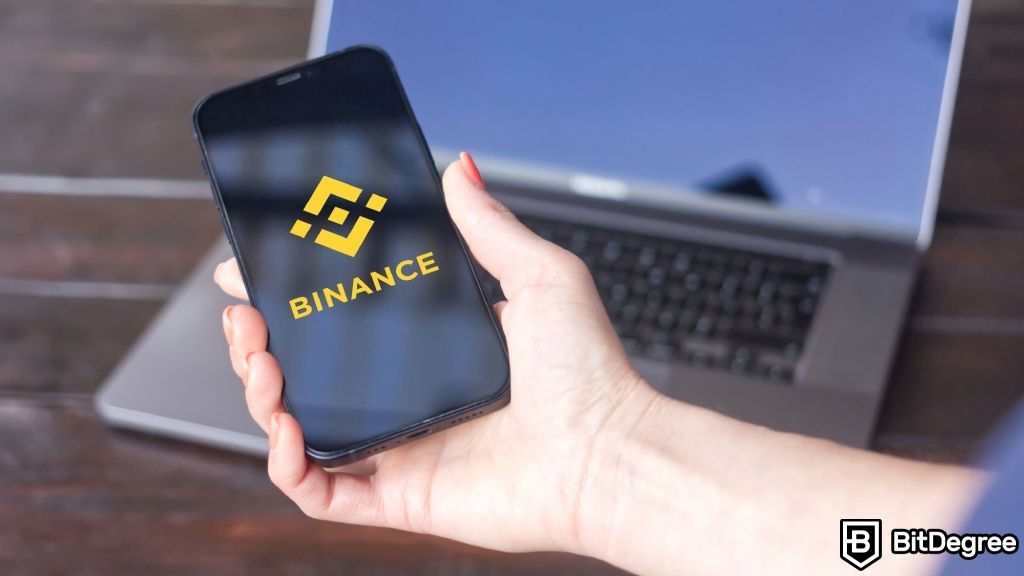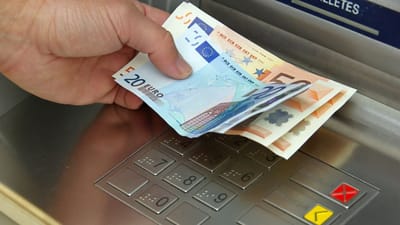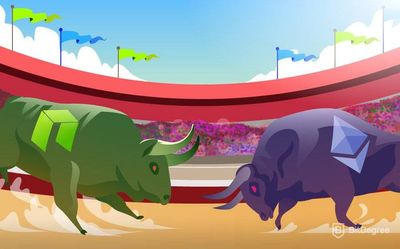Key Takeaways
- Margin trading on Binance allows you to use borrowed funds from the exchange to buy assets;
- Binance margin fees vary according to your trading volume over the last 30 days, how much BNB you hold, and / or how you choose to pay fees;
- Margin trading amplifies both profits and losses, so you should only engage in it after fully understanding how it works and never invest more than you can afford to lose.
Stop overpaying - start transferring money with Ogvio. Sign up, invite friends & grab Rewards now! 🎁
Curious about Binance margin trading? If so, you're in the right place. In this guide, I'll take you through the ins and outs of how to margin trade on Binance. Whether you're an experienced trader or new to the game, I've got you covered.
What exactly is Binance margin trading? What about Binance margin fees? How do I open a Binance margin trading account? What is the Binance Portfolio Margin mode?
You’ll find the answers to these and many more questions below. So, let's dig in and uncover how you can make the most of Binance margin trading.

Did you know?
Subscribe - We publish new crypto explainer videos every week!
Harmony ONE Explained (Beginner-Friendly Animation)


Table of Contents
- 1. What is Binance Margin Trading?
- 2. Binance Margin Trading Fees
- 3. How to Margin Trade on Binance?
- 3.1. How to Open a Binance Margin Account?
- 3.2. How to Transfer Collateral on Binance Margin?
- 3.3. How to Use Automatic Margin Trading on Binance?
- 3.4. How to Borrow Funds Manually on Binance?
- 4. What is the Binance Margin Lite Trading Mode?
- 4.1. How to Use It?
- 5. What is Binance Portfolio Margin Mode?
- 5.1. How to Use It?
- 5.2. How to Switch Between Portfolio Margin and Standard Trading Modes?
- 6. Conclusions
What is Binance Margin Trading?
So, you've heard about Binance margin trading, and you're curious to know what it's all about, right? Let’s break down the basics in a way that's easy to understand.
Latest Deal Active Right Now:Imagine you're at a garage sale, and you spot an antique vase that you're pretty sure is worth a lot more than the price tag. You're tempted to buy it, but you don't have enough cash on hand. That's where margin trading comes into play, but instead of antique vases, we're talking about cryptocurrencies.
Binance, a popular crypto exchange, offers a feature called Binance margin trading. Essentially, it's borrowing money from the exchange to increase the size of your trades[1]. This can potentially lead to bigger profits but also bigger losses, so it's important to tread carefully.
Here's how it works: Let's say you have 1 Bitcoin, and you believe its value will rise. With Binance margin trading, you can borrow additional Bitcoin from Binance, so you now control, let's say, 2 Bitcoins in total.
If the price goes up as you predicted, you'll make profits not just on your original Bitcoin but also on the borrowed one. However, if the price goes down, you'll still owe Binance the borrowed Bitcoin, and this is the risk you have to be aware of.
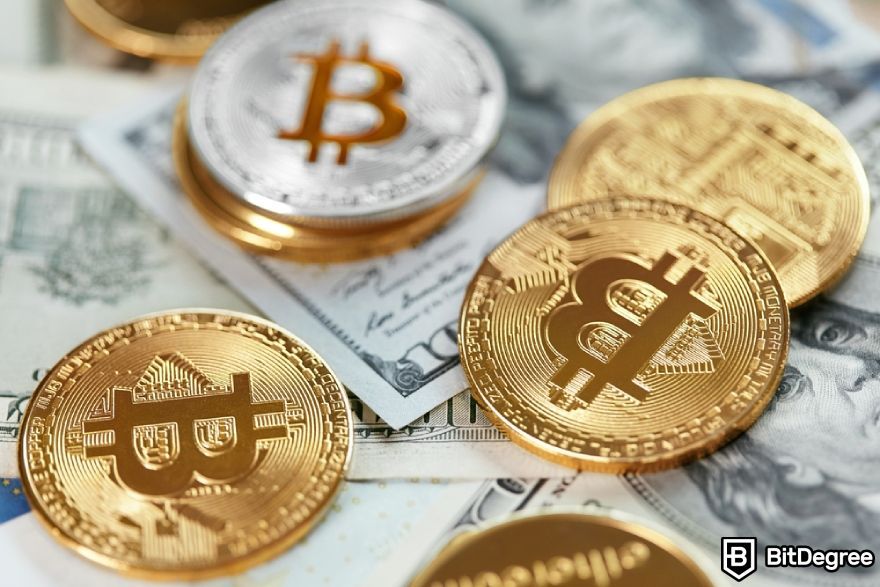
But hey, don't be discouraged! The key is to educate yourself and make informed decisions. Binance margin trading isn't just for the pros; beginners can dip their toes in, too. Just make sure you understand the concept, familiarize yourself with the terms (like leverage, liquidation, and interest rates), and start with caution.
Speaking of terms, let's unwrap some of the trading lingo you'll encounter when margin trading on Binance.
First up, there's leverage – think of it as the booster seat for your trades. It lets you control a bigger position with a smaller chunk of your own capital. For instance, with 5x leverage, $100 can get you $500 worth of trading action on Binance. While this can supercharge your gains, it can also magnify losses, so be careful[2].
Now, onto liquidation – imagine it as a safety net that stops your trades from tumbling into a debt pit. When your losses come close to certain limits, Binance sends margin calls. These are friendly notifications that remind you to add more margin. If you don't act, that's when liquidation takes the stage.

If your Unified Maintenance Margin Ratio (uniMMR) gets to or falls below 105%, Binance steps in to sell your assets, covering the losses and settling the debt. So, liquidation is a risk management tool triggered when everything else fails.
Moving further, let's not forget interest rates. If you're borrowing funds for margin trading, expect to come across interest rates. It's essentially the cost of using someone else's money to potentially rake in more of your own.
Now that you're well-versed in these trading terms, let's dive into the differences between isolated and cross margin modes on Binance margin trading.
First, there's the isolated margin mode. Think of it as setting a specific margin amount just for one trading gig. It's like assigning separate budgets to different trades and making sure they don't raid each other's wallets. Each trading pair gets its own space here, with its own rules.
So, if one position decides to hit the liquidation dance floor, the other positions can keep grooving without any interruption.

But you can also choose the cross margin mode. In this mode, your entire margin account balance waltzes in as collateral. This mode brings flexibility to the floor and requires less margin to keep the show going.
Just remember, if one position falters, it might dip into the funds of your other positions, a bit like juggling to keep the rhythm alive.
If you want to check Binance margin data on borrow interest, cross margin limit, cross margin collateral ratio, isolated margin pairs, market data, or price index, be sure to head to the Binance margin data page.
By the way, keep in mind that Binance allows you to borrow up to twice the value of your funds in your margin account. Thus, if you have 1 BTC, you can borrow 2 more BTC.
So, there you have it – the scoop on Binance margin trading. It's a tool that can potentially supercharge your crypto trading game, but it's also a playground where risks can't be ignored. Thus, remember to stay curious, learn from your experiences, and never invest more than you can afford to lose.
Binance Margin Trading Fees
Alright, now, let's break down the dollars and cents of Binance margin rates. Just like any journey, trading comes with its costs, so it's important to know what you're dealing with.
When you're engaging in Binance margin trading, you'll come across two types of fees: trading fees and Binance margin interest rates.
The trading fees are the same as those you have to pay for spot trading. They are based on the maker / taker model.
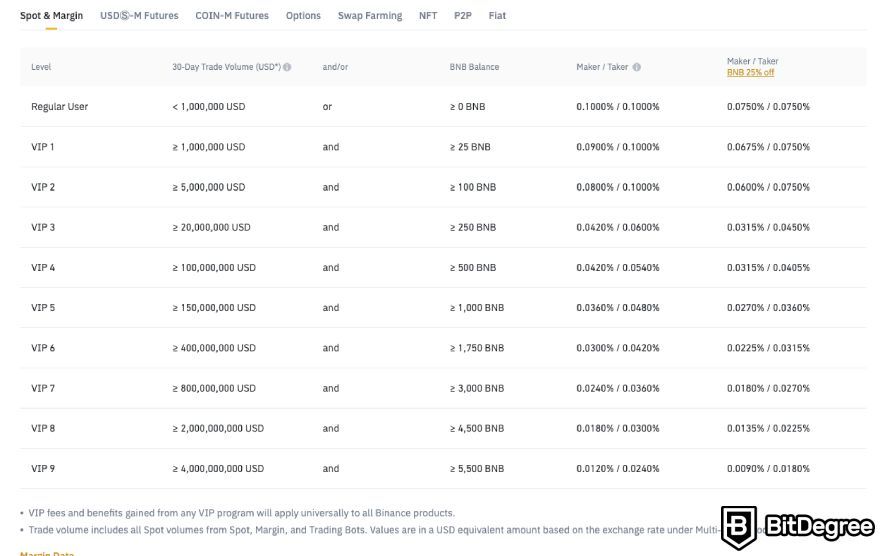
The maker fee comes into play when you place a limit order that doesn't get instantly matched, adding to the liquidity of the order book. The taker fee is for market orders that get matched right away, taking liquidity from the order book.
The specific fees you pay depend on your trading volume over the last 30 days, how much BNB you hold, and how you choose to pay fees.
For example, if you're a Binance user with a 30-day trade volume under 1,000,000 BUSD, less than 25 BNB, and you're not using BNB to pay your Binance margin fees, your maker and taker fees would both be 0.1%.
Now, let's talk VIP. The more you trade and / or the more BNB you hold, the higher your VIP status gets, and with higher VIP levels come lower fees. VIP 1 traders, for instance, have a 30-day trade volume surpassing 1,000,000 BUSD and / or hold 25 BNB or more. Because of that, they enjoy a maker fee of 0.09% and a taker fee of 0.1%.

You're probably wondering about that "25% off" on Binance margin fees, right?
Well, the 25% discount isn't tied to your BNB balance – it's for anyone who's using BNB to pay their trading fees. This means that those regular user fees drop to 0.075% for makers and takers, while VIP 1 fees drop to 0.0675% for makers and 0.075% for takers. It's like a little trading bonus for going the BNB route.
Moving further, as I've mentioned before, there is also the margin interest rate you have to pay for the borrowed funds. It's charged and calculated hourly and it differs based on the asset in question. For example, Bitcoin's hourly borrow interest is 0.000139% while Ethereum's is 0.00024521%.
By the way, just like with trading fees, the higher your VIP level is, the smaller interest you'll have to pay. Also, if you use BNB, you can get a 5% discount.
You can find the full margin fee structure in the Binance margin data page.
How to Margin Trade on Binance?
Since you know all the basics of Binance margin trading, let's get to the "how to margin trade on Binance" part. Firstly, you need to create a Binance margin trading account.
How to Open a Binance Margin Account?
I assume you already have a Binance account. If not, sign up.
Step 1: Log in to your Binance account. Once you're in, glance at the main navigation bar and spot the [Trade] option. Click on it, and then from the dropdown select [Margin].
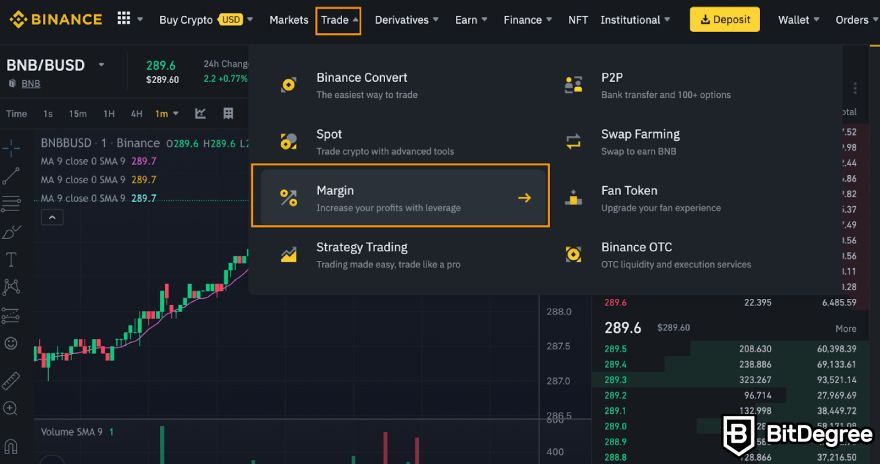
If you're using the Binance app, tap on the [Trade] button, and then navigate to the [Margin] tab. This will lead you straight to the Binance margin trading page.
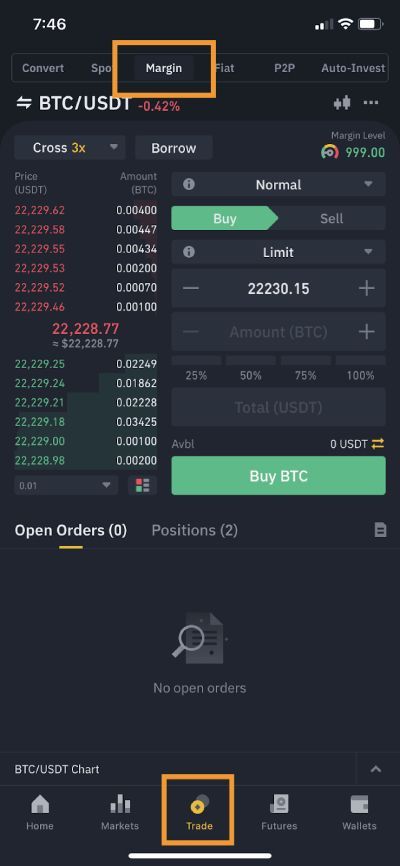
Step 2: Before you start trading, there will be a brief quiz you'll have to fill out. After you've entered the margin trading section, keep an eye out for a pop-up window. In that window, you'll spot a button inviting you to [Start the Quiz]. Click it to get things rolling.

Step 3: Here's where your crypto-savvy knowledge comes into play. You'll be presented with a series of questions, and it's your job to answer each of them correctly.
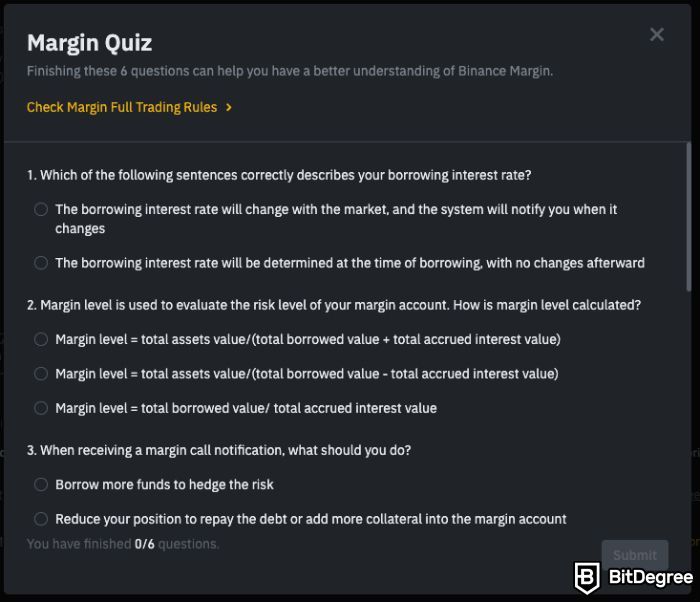
Step 4: Once you've demonstrated your expertise by acing the quiz, it's time to activate your margin account. With your newfound status, you'll have the green light to transfer funds into your margin wallet.
At this point, the action truly starts, as you'll be all set to begin your Binance margin trading journey and seize those opportunities.
How to Transfer Collateral on Binance Margin?
Now that you have an account, let's talk about transferring collateral.
Step 1: Take a look at the navigation bar above and find the [Wallet] option. When you click on it, you'll see a drop-down menu. One of the options there will be [Margin]. Go ahead and give that a click.

Step 2: In the Margin section, spot a button labeled [Transfer]. That's what you're aiming for. Click it to move forward.
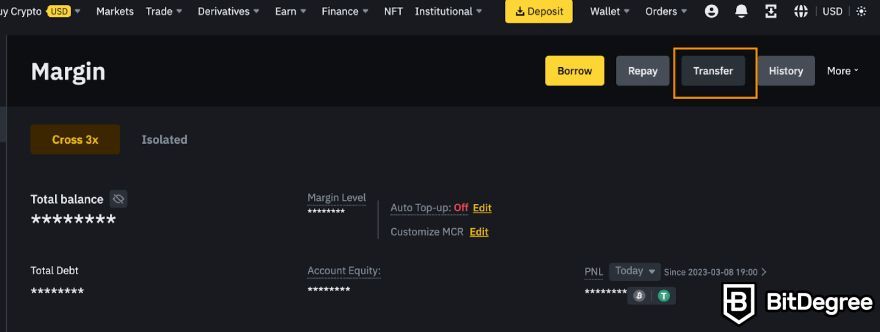
Step 3: The next screen will ask you to select the wallet you want to transfer from. This is where you choose the source of the collateral you'll be moving. Also, take a moment to choose the specific cryptocurrency you want to transfer. This is all about making sure you're on the same page with the platform.
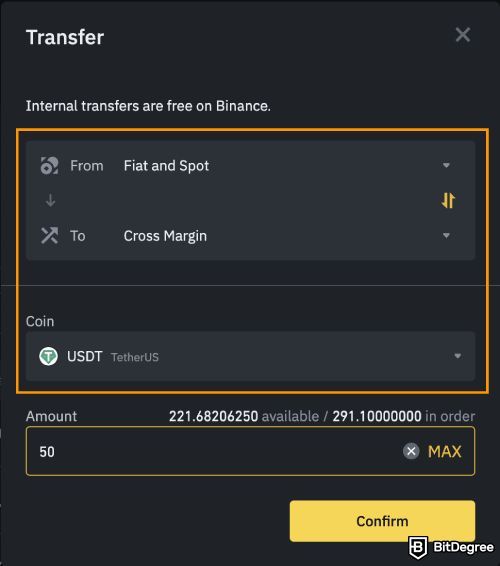
Step 4: Now, it's time to decide how much of that chosen cryptocurrency you want to transfer as collateral. This is a crucial step – the amount you pick will determine the scope of your margin trading possibilities. After you've locked in your amount, go ahead and give that [Confirm] button a tap.
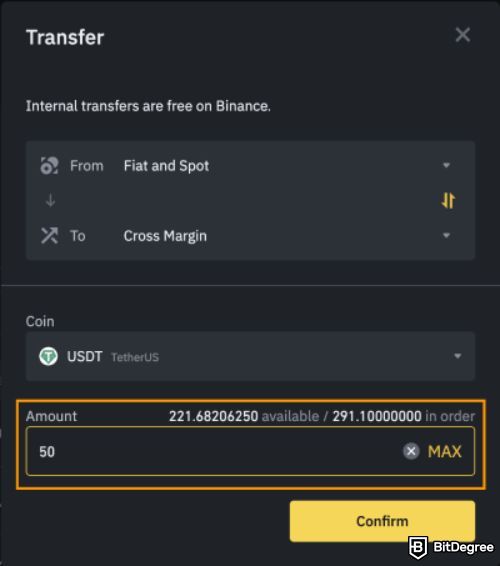
There you have it! You've successfully completed the steps to transfer collateral from your spot wallet to the Binance margin wallet.
How to Use Automatic Margin Trading on Binance?
Another thing you need to know about is the One-Click Borrow & Repay function on Binance margin. This feature can make your margin trading journey smoother than ever before.
But before we jump into the details, let's get a quick overview.
Binance offer three transaction modes for your orders:
- Ordinary Mode. Here, you use your existing crypto assets in your margin account to place buy or sell orders. In this mode, you manually borrow and repay assets on the margin platform, just like the good old traditional way.
- Automatic Borrowing Mode. This is where automation comes in. In this mode, the system automatically borrows the required crypto assets based on your maximum leverage.
- Automatic Repayment Mode. Once your buy / sell order is executed, the system takes the received crypto assets and uses them to automatically repay your liabilities.
The One-Click option activates these automatic modes.
If your balance isn't enough to cover the borrowed amount, the system makes a second repayment attempt using 90% of the received crypto assets. If that doesn't work either, you'll need to step in and manually repay.
A critical thing to remember: When you repay, you need to use the same asset you borrowed (for example, if you borrowed BTC, repay in BTC). Also, the interest gets settled before the principal amount.
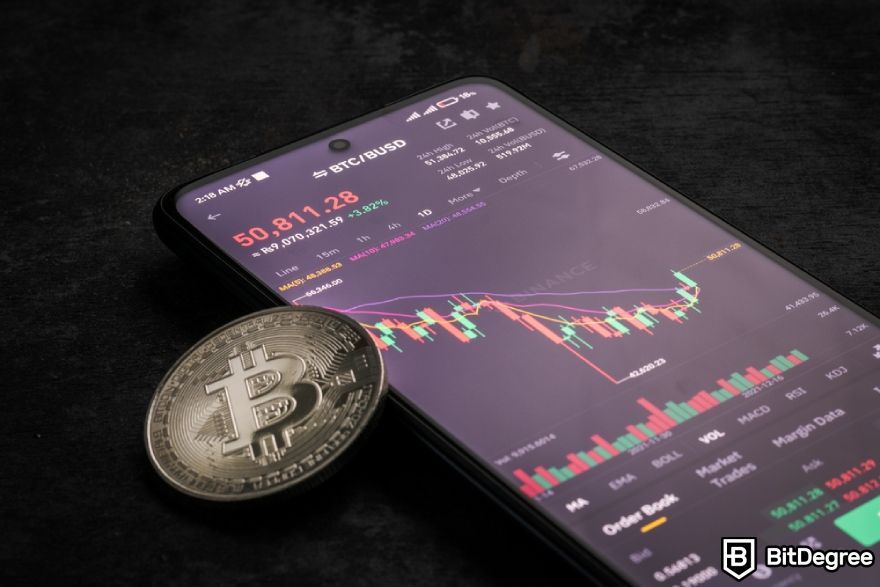
Besides that, here are some handy tips to keep in mind:
Want to track your assets, liabilities, and profits? Head over to [Wallet] - [Margin Account].
Curious about your borrowing and repayment history? Go to [Orders] - [Margin Order] - [Order History/Borrowing History/Repayment History] - [Cross Margin/Isolated Margin].
Canceled an automatic borrowing order? Don't forget, you might still incur some interest. Check your borrowing history in the [Borrowing History] section.
So there you have it, the ins and outs of using the One-Click Borrow & Repay function for automatic margin trading Binance.
How to Borrow Funds Manually on Binance?
Of course, if you don't want to use automatic borrowing, you can do it manually, too.
Step 1: Head over to the [Wallet] section and click on [Margin].
Step 2: Now that you're in the Margin section, you'll see the option to [Borrow]. Click on that, or if you've got a specific asset in mind, you can click [Borrow/Repay] right next to it.
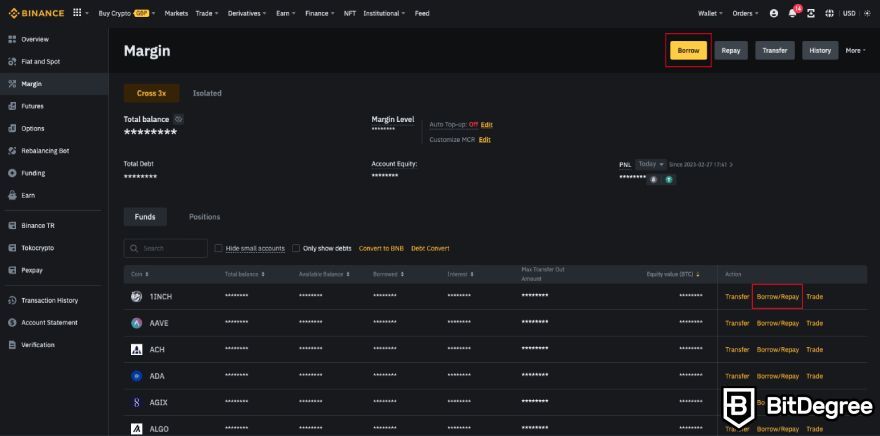
On the Binance App? No worries. Just tap on [Wallets], then [Margin], and finally, hit [Borrow].

Step 3: Pick the crypto asset you want to borrow and enter the amount you need.
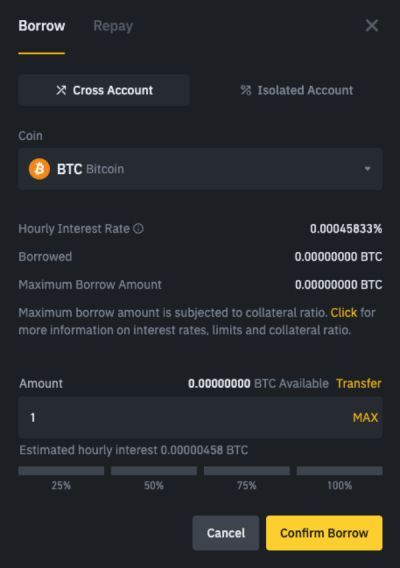
The system's got your back here – it'll calculate the maximum you can borrow based on your collateral's estimated BTC value and the asset's borrowing limit. You'll also get a peek at the estimated hourly interest. Once you're set, give that [Confirm Borrow] button a tap.
You've successfully borrowed the asset! Now, to keep track of your moves, head over to your Margin Account dashboard. You'll be able to see exactly how much of each coin you've borrowed and the total debt you're carrying.
What is the Binance Margin Lite Trading Mode?
Ever wished crypto trading on margin could be as simple as a walk in the park? If so, you'll be happy to learn that Binance margin trading has the Lite mode.
In Binance Margin Lite trading mode, you won't need to stress about order types or modes. It's trading with training wheels. Just pick the leverage you want, and the system handles the rest. It borrows assets for your trade and repays liabilities when you're done – all on autopilot.
Accessing this stress-free zone is a breeze – just grab the Binance App Pro version. Do note, though, that this isn't the same as Binance Lite. Binance Lite is for crypto beginners, while the Margin Lite Mode is your key to straightforward margin trading.
In a nutshell, with the Binance Margin Lite trading mode, you can dive into margin trading without the usual complexity.

Did you know?
Subscribe - We publish new crypto explainer videos every week!
What is an NFT? (Explained with Animations)
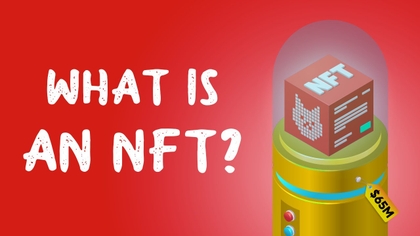

How to Use It?
Here's a step-by-step guide on how to use Binance Margin Lite trading mode.
Activating Margin Lite Trading Mode
Step 1: First things first, ensure you're logged into the Binance App using the Pro version. If not, you can switch over by heading to your [Profile] settings.
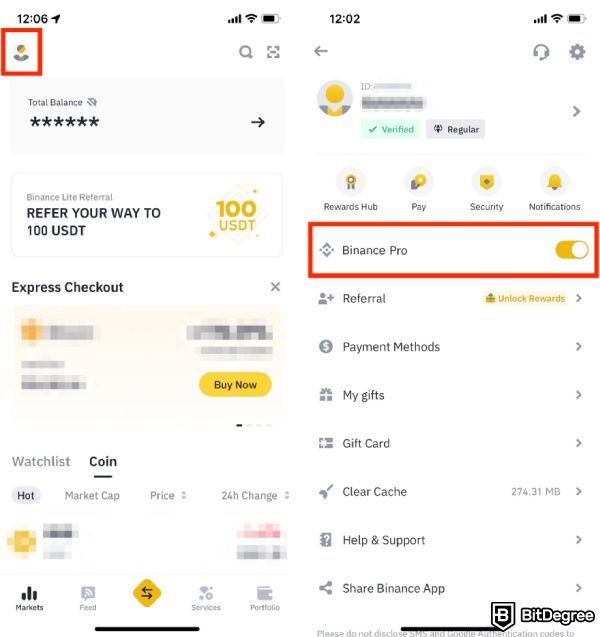
Step 2: Once you're in, take a glance at the bottom and tap on [Trade].
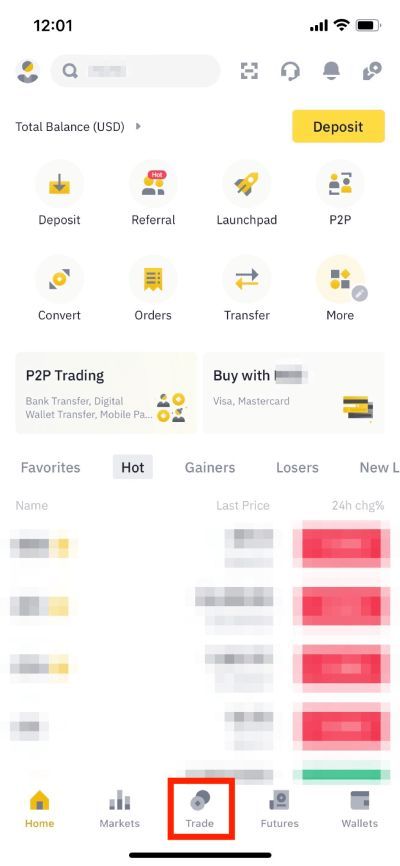
Step 3: Now, select [Margin] and tap the three dots [...] at the upper right corner. This will unveil more trading features.
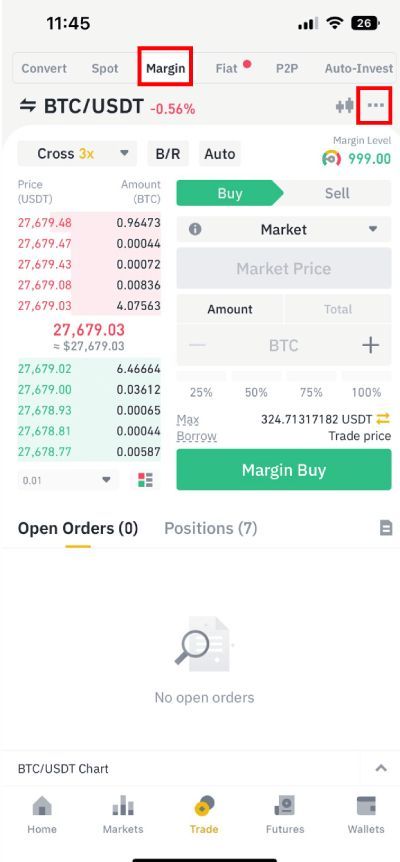
Step 4: Almost there! Time to tap on [Preferences] and then on [Trade Mode]. Finally, choose [Lite Trade Mode] to get started with Margin Lite Trading.
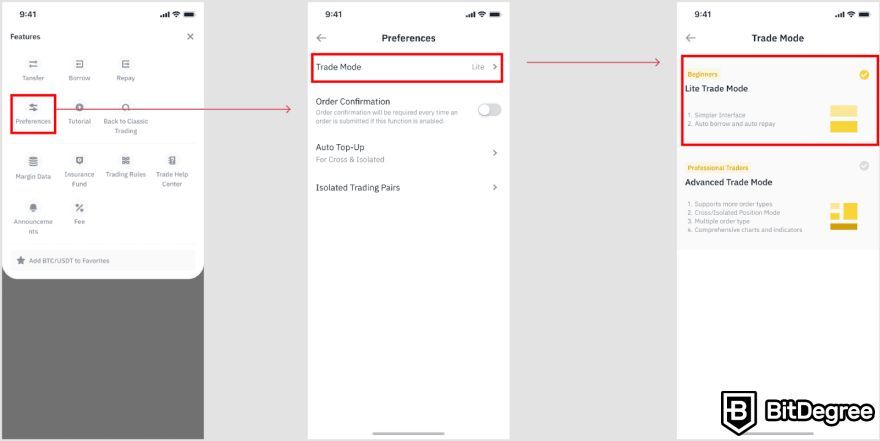
Placing an Order in Margin Lite Trading Mode
Now that you've activated it, you can place an order.
Step 1: Pick the crypto pair on which you want to place an order – let's say, it's BNB/USDT.
Step 2: Adjust the slippage tolerance to your liking. What's slippage, you ask? Well, it's the difference between what you expect to pay and what you actually end up paying due to market fluctuations. After you adjust it, decide if you want to go long or short on your position.
Step 3: Input the order amount you're comfortable with or choose a percentage based on your available assets.
Step 4: Give those order details a quick double-check, and when you're satisfied, hit the submission button.
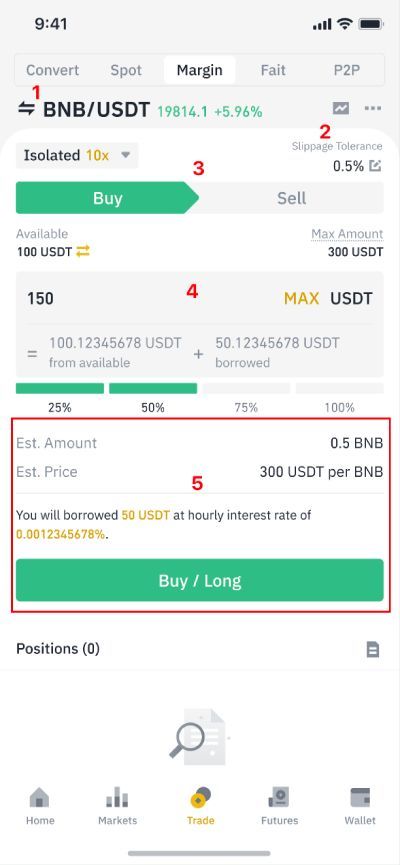
That's it, your order is placed!
Tweaking Slippage Tolerance
By the way, in the Margin Lite Trading Mode, you've got an exclusive feature – the ability to adjust the slippage tolerance after the order is already placed.
Step 1: To make changes to your slippage tolerance level, simply tap on the edit icon beneath [Slippage Tolerance].

Step 2: Pick the slippage tolerance you're comfortable with and wrap things up by clicking [Confirm].
.jpeg)
That's pretty much all the basics you need to know about the Binance Margin Lite Trading mode.
What is Binance Portfolio Margin Mode?
Now, when looking into Binance margin trading, you might've stumbled upon Binance Portfolio Margin mode. What exactly is it?
The Portfolio Margin mode is all about giving experienced traders some serious leverage and flexibility across a bunch of different trading goodies. We're talking about a way of trading that takes a different approach to how you calculate margins and manage risks. It's like leveling up your crypto trading strategies.
Now, one of the cool things about Portfolio Margin is that it lets you use multiple supported assets as collateral. You know, those assets that you're not actively trading at the moment? Well, they can still come in handy as collateral, boosting your flexibility in crafting those oh-so-smart trading strategies.
The good news doesn't stop there. You can play around with assets in your USD-M futures, COIN-M futures, and cross margin wallets. Once you've activated Portfolio Margin, these wallets become "Futures-PM Wallets" and "Margin-PM Wallets".
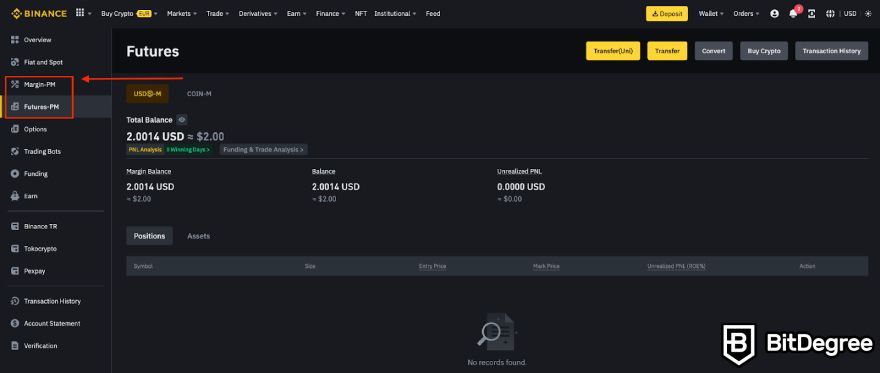
Just keep in mind that your assets in the isolated margin wallet won't join this party. As such, they won't be counted in the collateral and uniMMR calculations.
That said, what are the benefits of Binance Portfolio Margin Mode?
First off, as I've just mentioned, there's the cross-collateral support. Basically, you can use a lot of assets as collateral, giving your trading strategies a bit more flexibility. You can find the list of supported collaterals and their ratios on the Portfolio Margin collateral page.
Portfolio Margin also makes your trading life easier. No more juggling different margin requirements for different trading products. It's similar to having a single rulebook for all your margin trading Binance activity. It also helps you manage your portfolio better, making it easier for you to stay on top of things.
Besides that, Portfolio Margin integrates the unified maintenance margin requirement calculation, a risk management tool. The uniMMR considers your entire trading portfolio and gives you a clearer view of the risk you're exposed to across different assets. So, you're not flying blind when it comes to risk.
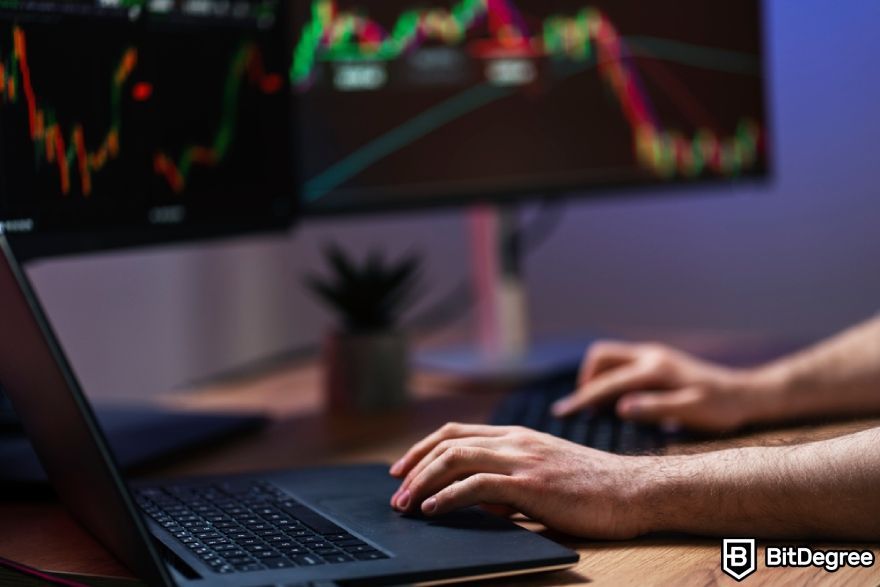
Now, the trading process itself becomes easier with Portfolio Margin. You can open and close positions within your Portfolio Margin account without breaking a sweat.
Besides, if you're into keeping tabs on your margins, there's a tool for that, too. It's called Margin Check Service (MCS). This little helper lets you figure out if your positions meet the required margins so you can keep those risks in check.
But who can actually access Binance Portfolio Margin mode?
Well, if you're a VIP 4-9 user, you've got access to the Portfolio Margin mode. If you're not quite there yet, don't worry, you can still request access by contacting Binance.

Did you know?
Subscribe - We publish new crypto explainer videos every week!
What is an NFT? (Explained with Animations)


How to Use It?
Here's a guide on using the Protfolio Margin mode.
Step 1: Check if you meet the requirements:
- No loans, open orders, positions, or negative balances in Cross Margin.
- For USD-M Futures (UM): No open orders, positions, or negative balances, and steer clear of isolated margin or Multi-Assets mode.
- For COIN-M Futures (CM): No open orders, positions, or negative balances, and don't play with isolated margin.
Step 2: To activate Portfolio Margin, head to the Binance Futures trading page. If you're eligible, you'll spot an [Upgrade] button beside [Margin Ratio]. Click it.
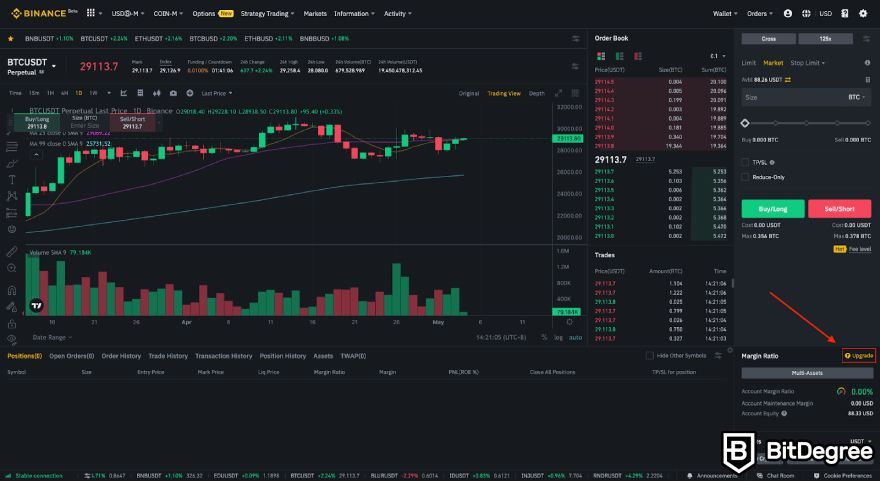
Alternatively, hit up [Preferences] - [Account Mode], and you'll find the [Upgrade] button waiting for you at the top.
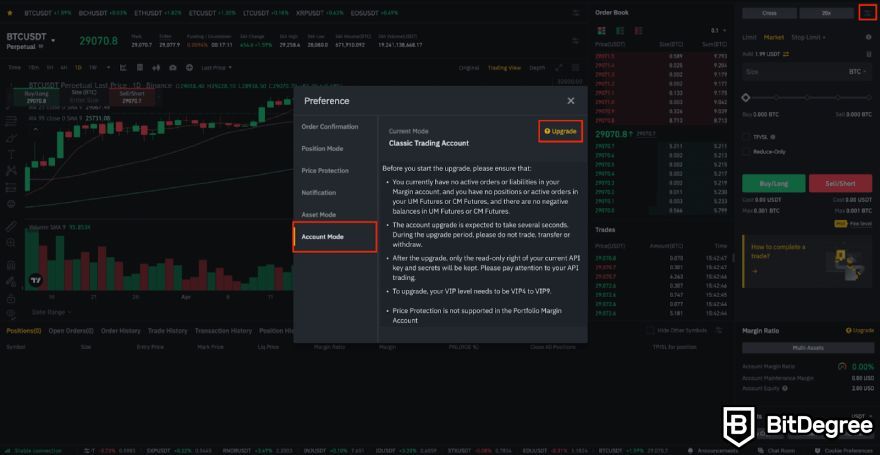
Step 3: Before you fully dive in, you'll need to take a little quiz. This helps ensure you understand the rules, risks, and benefits of Portfolio Margin trading.

Step 4: Once you've aced the quiz, you'll be asked to confirm the activation. Hit that [Activate] button, and wait a bit (it should take arounf 15 seconds).
Alternative: You can also activate Portfolio Margin from your wallet page. Head to [Wallet] - [Futures]; if you're eligible, you'll spot the upgrade button on the right side.
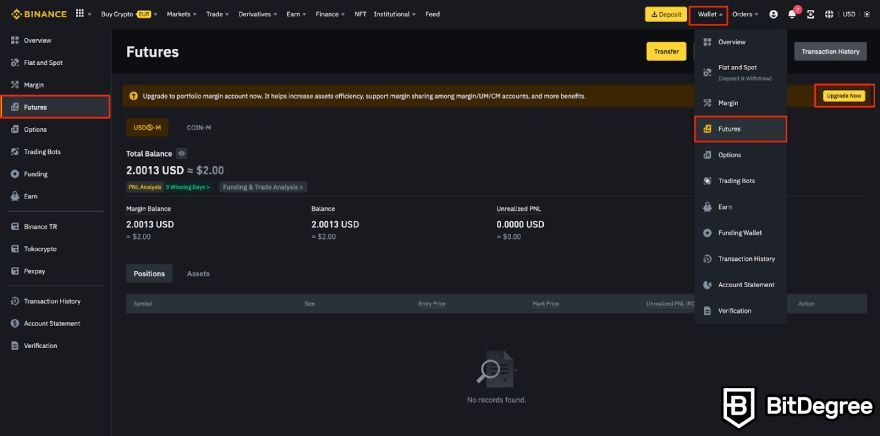
Keep in mind that if you're not eligible, you'll get an error message. Take a look at that message and figure out what's needed before you give upgrading another shot.
Once you've activated Portfolio Margin, your trading interface will change. Keep an eye on the lower right corner – that's where you'll spot the Portfolio Margin Information.
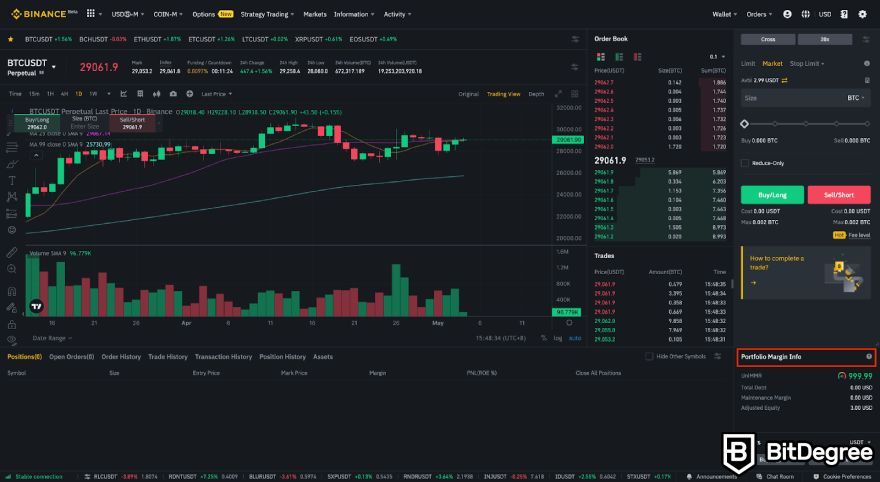
This includes UniMMR, total debt, maintenance margin, and adjusted equity.

- Secure and reliable
- Accepts fiat currencies
- Lots of trading options
- Reputable exchange
- Accepts fiat currencies
- Offers various trading options

- Huge trading variety
- Regulation-compliant around the globe
- Fair trading fees
- Beginner-friendly
- A wide array of features
- Vast number of different crypto coins & tokens

- Beginner-friendly
- Secure
- Decent trading and withdrawal fees
- Crypto.com Visa Card
- Automated tools & bots
- Ecosystem synergy with CRO
How to Switch Between Portfolio Margin and Standard Trading Modes?
Don't want to participate in this trading mode anymore? Let's talk about the process of switching between Portfolio Margin and standard trading modes from different interfaces of the Binance platform.
From Trading Interface
Step 1: Look for the [Settings] icon and click it. A menu will pop up, and among the options, you'll see [Preferences]. Go ahead and click on that.
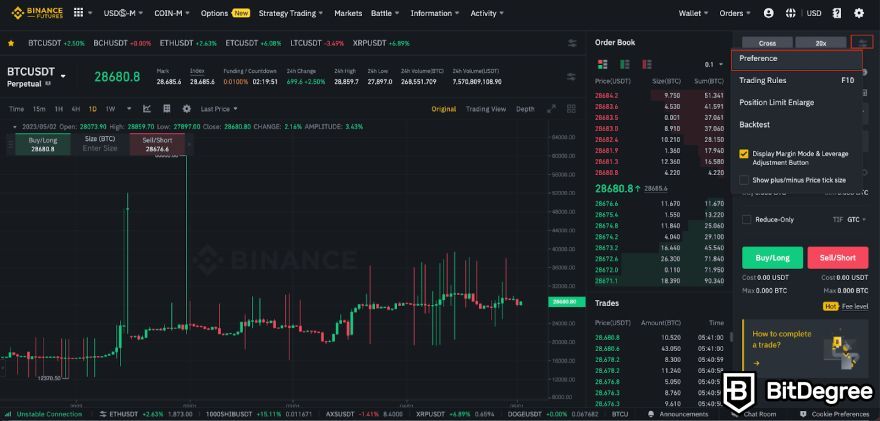
Step 2: After clicking [Preferences], you'll see a few tabs. One of them is labeled [Account Mode]. Give that tab a click.

In Account Mode, you'll find your current mode displayed. If you want to switch from Portfolio Margin to standard trading, or the other way around, just toggle between the modes.
From Wallet Interface
Step 1: Start by heading over to the [Wallet] section. Once there, find [Futures-PM] and give it a click. Inside the [Futures-PM] area, you'll find the [Back to Default Trading] button. Click on it.

Step 2: After clicking that button, a pop-up will appear, asking you to confirm your choice. Go ahead and click [Confirm].
.jpeg)
Just keep in mind that the Portfolio Margin mode has its quirks. While it's awesome for trading, it doesn't really play nice with most trading bots. However, if you're into futures grid trading, that's a different story.
If you're planning to switch back to the default trading mode, make sure you deal with any negative balance first. It's a bit like tidying up your room before moving to a new one.
And here's a techie tip: If you're all about APIs, you'll want to recreate your API Key after you've switched between modes. This keeps your access smooth and glitch-free.
Conclusions
I hope that this comprehensive guide to Binance margin trading has helped you, and that "How to margin trade on Binance?" is no longer a question you can't answer. Just remember, margin trading can be a powerful tool to amplify gains, but it's a double-edged sword.
Before you dive in, make sure you've got the knowledge: get a good grip on leverage, manage those risks, and never put in more than you can afford to let go of.
Nevertheless, Binance is a reliable and user-friendly platform, so once you're well-versed in margin trading, you'll notice that it might just be the only platform you'll need (for this or any other type of trading).
The content published on this website is not aimed to give any kind of financial, investment, trading, or any other form of advice. BitDegree.org does not endorse or suggest you to buy, sell or hold any kind of cryptocurrency. Before making financial investment decisions, do consult your financial advisor.
Scientific References
1. Z. Huang, Y. Wu: 'Short-Selling, Margin-Trading, and Market Valuation';
2. J. Bian, Z. Da, Z. He, D. Lou, K. Shue, H. Zhou: 'Margin Trading and Leverage Management'.
